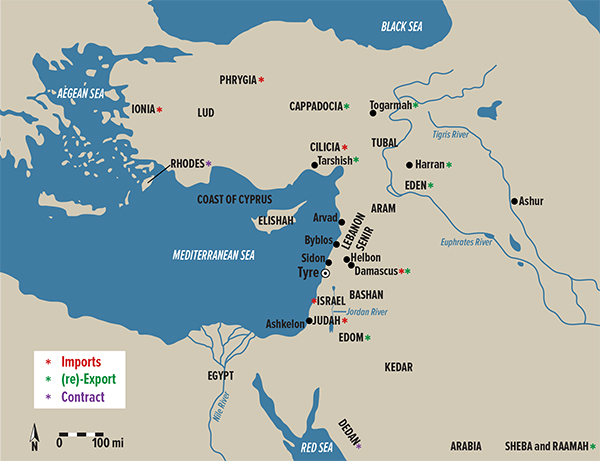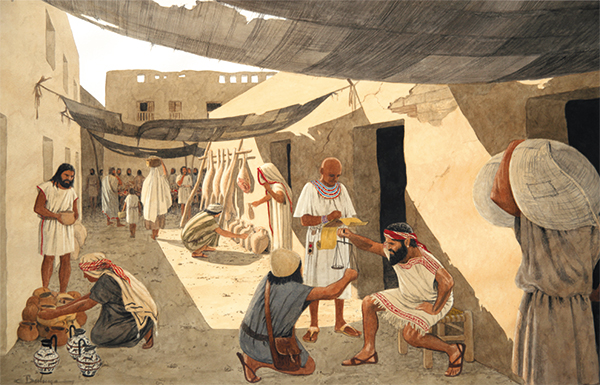
Ashkelon—an ancient city whose name comes from the same root as shekel—was indeed a city of buying and selling. If archaeologists were to design a place to examine the economy of the ancient world, they could hardly pick a better site than Ashkelon. At the end of the South Arabian overland spice routes, Ashkelon was a major city with the region’s largest Mediterranean port. Since 1985, archaeologists of the Leon Levy Expedition to Ashkelon have carefully sifted through the remains of the ancient city in search of evidence of international trade.
In the seventh century B.C.E., on which we will focus here, Ashkelon extended for more than 150 acres, with 12,000 to 15,000 people within its ramparts. To feed that number of people on the surrounding arable land was impossible given the few rural settlements within farming range of Ashkelon. Although Ashkelon was not a supersize agrarian kingdom, it was a commercial one, where trade, not agriculture, was the primary mode of sustenance.
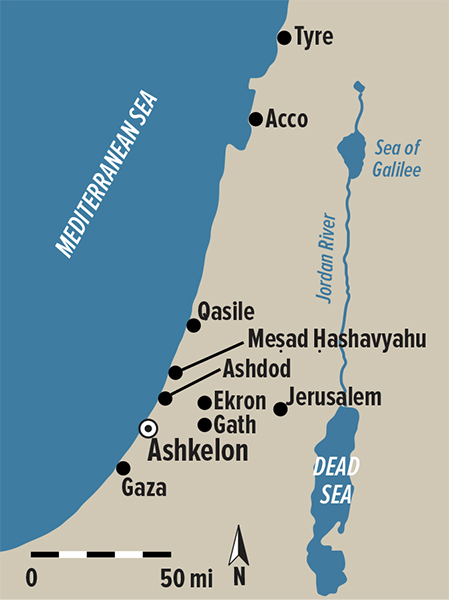
In the seventh century, Ashkelon was a thriving member of the Philistine pentapolis so vividly portrayed in the Bible. Like Gaza and Ashdod, it lay on the coast, a port city. The other two members of the Philistine pentapolis, Ekron and Gath, lay inland. To Ashkelon’s east lay Judah, now effectively an Assyrian province since Sennacherib’s incursion at the end of the eighth century B.C.E. Both Ashkelon and Jerusalem would be utterly destroyed at the end of the Iron Age by the superseding world power, Babylon.a
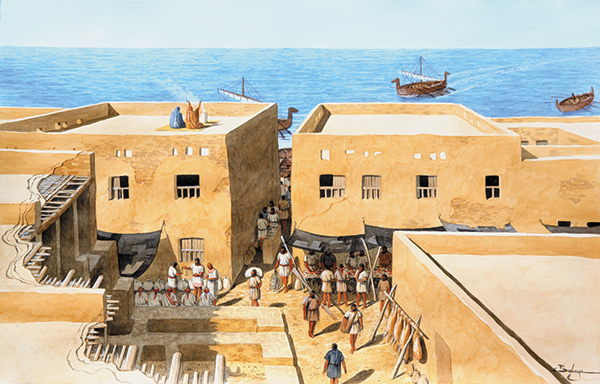
Thirty years ago, we decided to work at Ashkelon because of its rare combination of size and international access. In a stroke of luck, we uncovered a remarkable marketplace that has vastly expanded our understanding of economic activity in the ancient Near East. A variety of experts have brought their specialized knowledge to bear, enabling us to understand—in many ways for the first time—how an ancient marketplace worked.
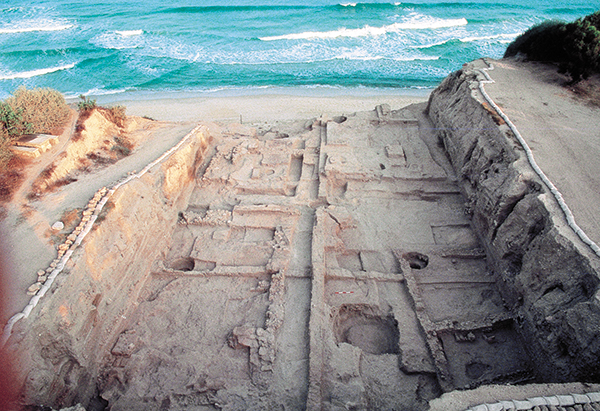

Some anthropologists once fantasized that ancient people were akin to “noble savages,” not accustomed to an entrepreneurial life but passing around prestige items and gifts for the good of society. This scholarly myth was long ago shattered by the 20th-century discovery and analysis of thousands of Bronze Age texts from Kanesh in Turkey, which reveal ancient merchant families selling cloth from Ashur in Iraq in exchange for gold and silver from Turkey’s Bolkardağ mines, while competitively solving problems of supply, demand, taxes, transportation costs and price fluctuations—the same issues facing businesses today.1
Another important snapshot of economic thinking was revealed by two eighth-century B.C.E. Phoenician ships, which we uncovered in 1999;2 they were swamped and sank in the Mediterranean Sea west of Ashkelon.b These vessels show the Phoenician mastery of logistics. They knew how to assemble and package shiploads of wine and oil. They also knew who in the Mediterranean world would pay the highest price. In a lengthy prophecy against Tyre, the prophet Ezekiel refers to a host of imported goods enjoyed by a Phoenician city:
Of junipers from Senir they built
All your frames;
A cedar from Lebanon they too
To make a mast over you;
Of oaks from Bashan
They made you oars;
Your deck cabin they made of ivory-inlaid cypresses
From the coasts of Kittim;
Fine embroidered linen from Egypt
Was your awning
Serving as your ensign;
Of bluish-purple and reddish-purple
From the coasts of Elishah
Was your canopy.
(Ezekiel 27:5–7, translation by Lawrence Stager)
From Tarshish came iron, tin and lead. From Beth-Togarmah came horses and donkeys. From Aram, turquoise and coral. Wheat, honey, oil, wine and wool are also mentioned—and on and on (see “Where Tyre Traded”). All this “shall go down into the depths of the sea,” according to Ezekiel’s prophecy (Ezekiel 27:27).
Yet neither the Old Assyrian texts nor the Phoenician ships nor Ezekiel could give us a complete picture of economic activity in ancient times. Was buying and selling part of everyday life or just the province of a special class? How widespread and pervasive was this kind of economic activity?
Normally when a shop goes out of business or a city is conquered, all the goods for sale are taken away. Little is left for the archaeologist to reconstruct.3 Nebuchadnezzar’s late seventh-century B.C.E. destruction of Ashkelon, however, provided a unique archaeological context. Nebuchadnezzar burned the entire city, but the wreckage was too large for even his armies to loot completely. Seventh-century Ashkelon became an ideal time capsule, and it preserved the ancient Near East’s only archaeologically demonstrated marketplace.
We completed the excavation of the Ashkelon marketplace in 1994, but it has taken us nearly two decades to extract its secrets. It has been almost like another excavation, using the latest scientific techniques and scholarship to fathom the secrets of what we have excavated (and write it up in a final reportc).
Only at the end of the process with all the studies in hand did we come to realize that our most important discovery regarding seventh-century B.C.E. Ashkelon—and one of the most important discoveries in 30 years of excavation—is its permanent urban marketplace that provides direct evidence for an integrated market economy in an Iron Age seaport.4
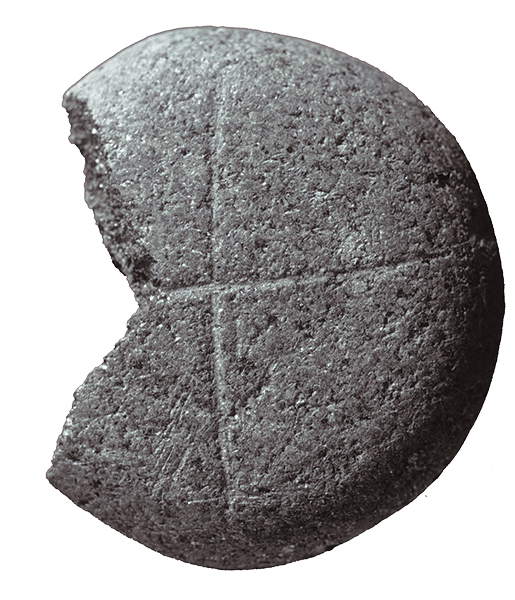
The weights and balances excavated in, as we call it, South Street indicate a location for weighing silver in exchange for goods or services. The mechanisms of exchange are clear. The weights related to several metrological systems, hence corresponding to a diverse clientele. This diversity is one of the first indicators of a wide range of buyers and sellers—not a specialized few—thrown together in the marketplace.
Skinned sheep were sold piece by piece until all that remained were the heads, which were discarded in the streets. Brian Hesse’s study of the bones identified the portions of the carcass that remained after the butcher was finished selling the meat. In another study, Omri Lernau showed that Nile perch and sea bass came in with the ships.
Through an amazing piece of scholarship, Mordechai Kislev and Ehud Weiss were able to show where much of the marketplace grain came from.d While grain may be the same all over, certain weeds grow only in specific geographic zones, and Weiss and Kislev were able to locate the origin of the weeds that had been unintentionally gathered with the grain. Some sacks of wheat were imported overland from Judah, and other sacks came by ship from the Sharon plain, near Tel Aviv.
Bulk trade in grain also came from Egypt to eastern Mediterranean ports—“from the grain of Shihor, the harvest of the Nile,” as Isaiah put it (Isaiah 23:2–3). Given the friendly relations between Ashkelon and Egypt in the seventh century, which precipitated Nebuchadnezzar’s sweeping destruction of the city in 604 B.C.E., it seems likely that some cereals also came from Egypt.
Of course such products as meat, grain and fish were not exotic goods; they met everyday household needs. As evidence for common people, not only elites, patronizing the Ashkelon marketplace, Egon Lass, through his study of microartifacts, discovered a bowl of eggs and fish eaten by one shopper who was simply passing through.
The Ashkelon marketplace also offered upscale products, such as beautiful East Greek pottery. Today we call these Greek vessels “South Ionian Archaic stemmed dishes” or “Wild Goat oinochoai,” but to the ancients these were simply the best ceramic tableware that money could buy. Jane Waldbaum studied these vessels for more than a decade and uncovered the trading networks by which Greek merchants were operating in every port on the coast of Canaan. The Greek pots were such a hit that they can be found in coastal settlements from Spain to the Black Sea to Ashkelon. At Ashkelon, these Greek decorated vessels competed in the high-end market with Cypriot bowls and amphorae as well as with a panoply of items offered by the Phoenicians.
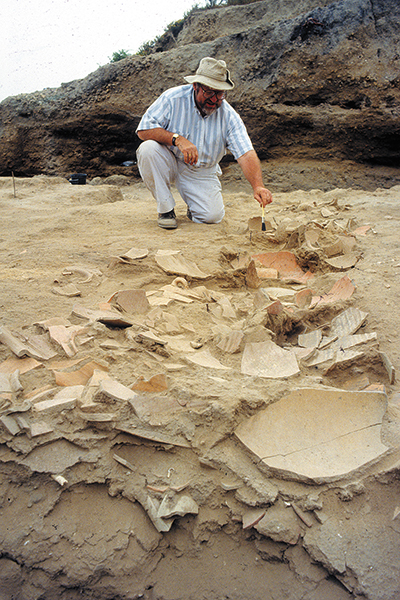
Not every piece of pottery was a thing of beauty, however. The rough “local” cooking pot was a specialized vessel made just outside Ashkelon and brought to the city for distribution via the market. It competed with cooking pots from Phoenicia, Syria and even Greece. The kitchens of Ashkelon had access to special kitchenware from all over the eastern Mediterranean.
In short, all the necessities and luxuries of life were discovered together in the Ashkelon marketplace, from the grain, meat and wine for daily subsistence to elegant Greek oinochoai. These products were found in quantities and patterns of spatial distribution indicating that the marketplace was not only for exchange and distribution (including redistribution inland) but also for final consumption; there were retail shops as well as wholesale warehouses. Looking at the layout of the market, it is clear that the shops had no place to store goods received back in barter. In this setting, a person could not bring a sheep to the market and expect to trade it for a decanter of wine. Rather, the wine shop and the butcher shop and the pottery merchant all were paid in silver weighed at the local scale.
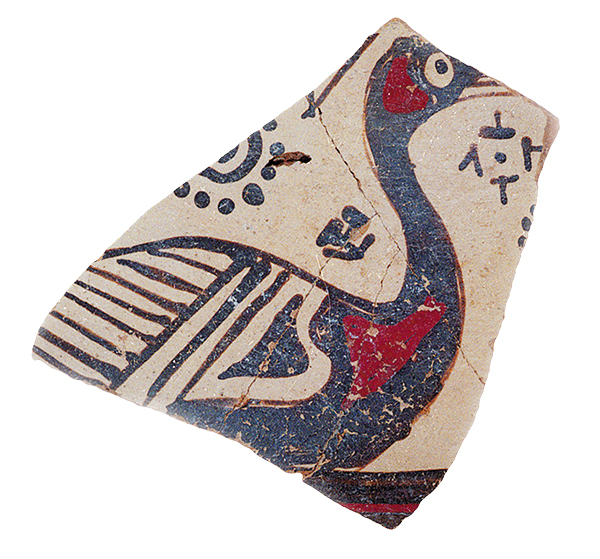

Land-based economies of course differed from those like Ashkelon based on maritime trade. In agricultural economies of highland kingdoms like Judah, economic activity was closely tied to periodic harvests; the possibilities for economic expansion were limited by the carrying capacity of the land. As a result, internal trade was less developed, and conquest was the easiest path to expansion.5 At Ashkelon, however, the local agrarian economy of the highlands and the commercial concerns of the Mediterranean came together in a year-round flurry of trade and exchange. The economy grew, not through conquest, but by bringing together more producers and more consumers. This was the secret of the legendary wealth of Phoenicia (Ezekiel 27–28), and the force behind Ashkelon’s market as well.
Trade from Ashkelon inland radiated in many directions. In our petrographic study, we found evidence of trading contacts as far as the Aravah (Negev) and Edom, far southeast of Ashkelon. While some of the trade routes—perhaps most of them—were a consequence of Ashkelon’s role as an outlet to the sea,6 the diversity of attested landward connections indicates that Ashkelon paid attention to the inland regions as well. Ashkelon, of course, was a Philistine city, and we might suppose that Ashkelon’s natural allies were cities like Gaza and Ekron. No doubt this was typically true, but in the eighth century, Ashkelon’s ruler looked even farther to the east and made an ill-fated alliance with Hezekiah of Judah to rebel against Assyria and dominate the rest of Philistia, even to the extent that Padi, the ruler of Ekron, was temporarily deposed. The reasons for Ashkelon’s alliance with Judah are not entirely clear, but at Ashkelon, economic concerns could trump personal relationships.
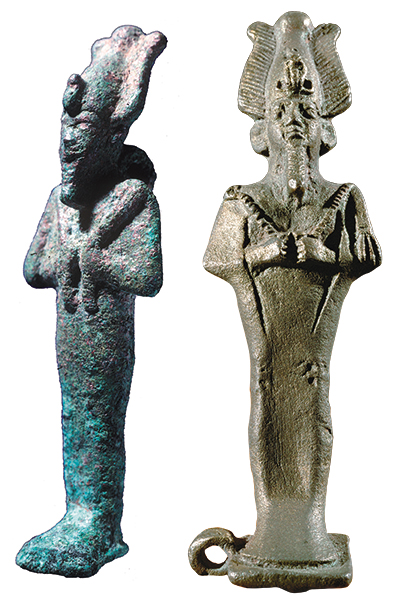
Our investigation of the Ashkelon marketplace also carries implications for questions of historical interpretation. In 1960, a small fortress known as Meṣad Ḥashavyahu was excavated on the coast of Israel. In the gate, archaeologists found seven Hebrew inscriptions. One of these inscriptions records a dispute between an unnamed servant and an overseer named Hoshayahu ben Shabay.7 The end of Overseer Hoshayahu’s name (-yahu) is a theophoric element, indicative of a Yahweh worshiper from Judah. On this basis, two very prominent scholars, American Frank Cross and Israeli Joseph Naveh, proposed that the site was a Judahite outpost. They explained the presence of Greek pottery at the site as belonging to Greek mercenaries that the Judahite king hired to man the fortress. More recently Israeli scholars Alex Fantalkin and Nadav Na’aman have proposed that the Greek mercenaries served Egypt, not Judah, and, therefore, the fortress was Egyptian.
Strange as it may seem, the Greek pottery from Ashkelon may have resolved this dispute. Jane Waldbaum, who assembled the Greek pottery from Ashkelon, noticed that everyone who could afford the elegant Greek wares seems to have possessed a cup or two. In short, Greek pottery was ubiquitous. Indeed, Waldbaum observed that the same Greek pottery has been found all over the Mediterranean, from Histria on the Black Sea to Huelva in Iberia. Hence, the Greek pottery is not a marker of Greek mercenaries serving Egypt but of Greek international trade. Indeed, at Meṣad Ḥashavyahu Greek pottery was found right in the city gate where commerce took place. Rather than being signs of the Egyptian domination of Judah, this pottery shows Judah’s involvement in Mediterranean trade. In short, the Hebrew inscriptions from the Meṣad Ḥashavyahu gate indicate a Judahite outpost, just as Cross and Naveh had proposed.
Ashkelon’s market also helps explain the economic development of all of Philistia in the seventh century B.C.E. Sometime after the Assyrian conquest of Judah in 701 B.C.E., Philistine Ashkelon invested heavily in wine production, and Philistine Ekron turned to olive oil production. At both of these sites, the inhabitants expanded capacity by building additional household production units. These households were not like modern factories, in which each group specializes in one part of the manufacturing process. Instead, every Ashkelon household produced the same goods from beginning to end. This approach may not be efficient by modern standards, but it was an easy way to increase output for societies with an abundance of cheap labor.
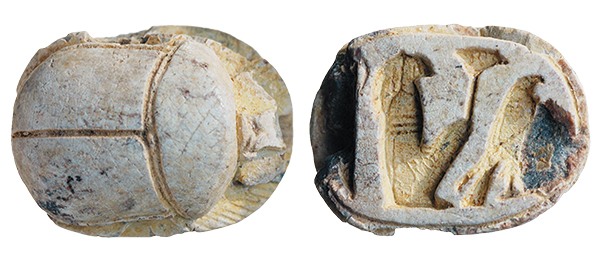
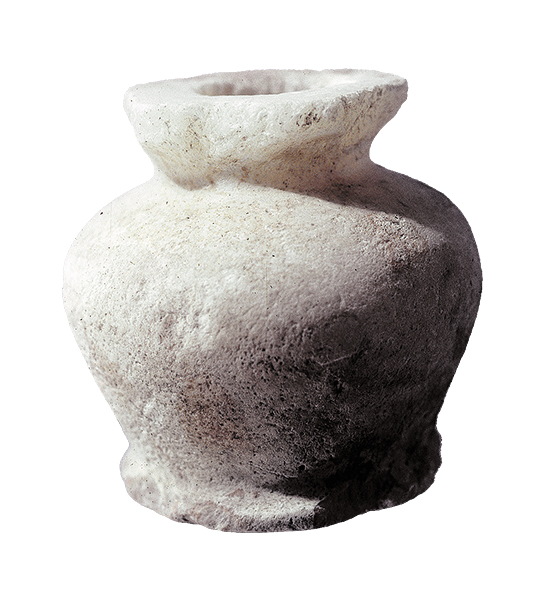

The impetus for Philistine expansion in the seventh century B.C.E. was the pull of the Mediterranean markets. Just as we can show that grain and fish and fine tablewares were coming in, the discoveries at Ashkelon and Ekron also show us that wine and olive oil were going out. The strength of this international market has been recently demonstrated by archaeologists and mathematicians from Tel Aviv University, who showed that Phoenician potters made the winejars found on the Ashkelon shipwrecks according to Egyptian standards: Each jar was specially designed to contain four Egyptian hekats of wine. By the eighth century B.C.E., Egypt’s customers were powerful enough to influence daily practices of potters as far away as Lebanon. The Philistines of the seventh century B.C.E. served these same customers in these same markets. With ready partners in Egypt and Phoenicia, the Philistines realized the financial opportunity in front of them. Ashkelon’s marketplace was simply the most obvious manifestation of Philistia’s new export economy.8
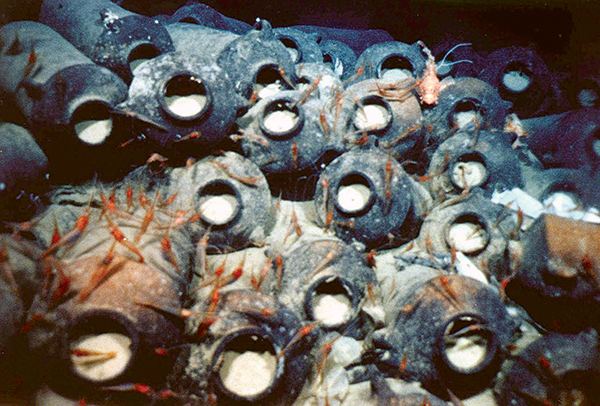
The commercial seaport of Ashkelon successfully negotiated the economic and political world of the southern Levant for many years, and at the end of the seventh century, the city fell under the protection of Egypt itself. We found an assortment of Egyptian seals, amulets and bronzes that pointed to the presence of Egyptians supervising production in the winery or transactions at the scales. Some of the Egyptian finds, such as the statue of Osiris or travertine alabaster, could have been desired by anyone at Ashkelon, but Egyptians at Ashkelon even brought rough bowls and kraters made of porous Nile mud. No one would trade for such objects; they had to be the calling card of actual Egyptians participating in life at Ashkelon. Yet, even with Egypt’s help and the power of Mediterranean trade, Ashkelon could not compete with armies from Mesopotamia. By the late seventh century Ashkelon was on the brink of destruction, whether its inhabitants realized it or not. Nebuchadnezzar claims to have made the site “a tell,” and our excavation bears out his boast.
From the perspective of the modern historian, Nebuchadnezzar could hardly have picked a better place to demolish. By his sack of the city, he sealed in its ruins. Greek, Cypriot and Phoenician pottery, together with local pottery of the southern Levant, were trapped in the rubble.
In the course of our years at Ashkelon, first in excavation and then in publication, we have learned the secrets of the bones, seeds, metal and pottery the people of the city produced and just what kind of life they enjoyed in the days before the end. We also found that their economic life was a lot more modern than might have been expected of an ancient society. They imported and exported, bought and sold, and enjoyed a standard of living that would have been the envy of their neighbors. In the end, however, like their Judahite neighbors to the east, they were no match for their destroyer, Nebuchadnezzar of Babylon.
MLA Citation
Footnotes
Lawrence E. Stager, “The Fury of Babylon: Ashkelon and the Archaeology of Destruction,” BAR, 22:01.
Aaron Brody and Anna Marguerite McCann, “Exploring the Deep,” BAR, January/February 2003.
See the review by William G. Dever “Back Breakers from Ashkelon and Hazor,” BAR 39:02
Ehud Weiss and Mordechai E. Kislev, “Weeds & Seeds: What Archaeobotany Can Teach Us,” BAR 30:06.
Endnotes
On mining see K.A. Yener, “The Archaeometry of Silver in Anatolia: The Bolkardağ Mining District,” American Journal of Archaeology (1986), pp. 469–472; on the old Assyrian Caravan Trade, see the summary by K.R. Veenhof, “Kanesh an Assyrian Colony in Anatolia,” in J.M. Sasson, ed., Civilizations of the Ancient Near East (New York: Scribner, 1995), pp. 859–871.
See R.D. Ballard and Lawrence E. Stager et al., “Iron Age Shipwrecks in Deep Water Off Ashkelon, Israel,” American Journal of Archaeology (2002), pp. 151–168 and Lawrence E. Stager, “Phoenician Shipwrecks and the Ship Tyre (Ezekiel 27),” in J. Pollini, ed., Terra Marique: Studies in Art History and Marine Archaeology in Honor of Anna Marguerite McCann (Oxford: Oxbow Books, 2005), pp. 238–254.
Several potential locales for ancient markets have been identified in the ancient Near East. See Larry Herr, “Tripartite Pillared Buildings and the Market Place in Iron Age Palestine,” Bulletin of the American Schools of Oriental Research (1988), pp. 47–67 and Avraham Biran, “The hûṣôt of Dan,” Eretz-Israel 26 (1999), pp. 25–29 (in Hebrew). The oldest proposed market is at Mari; see J.C. Margueron, Mari, métropole de l’Euphrate au IIIe et au début du IIe millénaire avant JC (Paris: Picard, 2004), pp. 160–162 (in French). But Mari and the other proposed markets lack the in situ artifacts that show trade in action. Ashkelon’s market is the sole space in which the architecture, goods for sale and receipts of sale are all found together; it is the only archaeologically demonstrated market in the ancient Near East.
See L.E. Stager, D.M. Master and J.D. Schloen, Ashkelon 3: The Seventh Century B.C. (Winona Lake, IN: Eisenbrauns, 2011) with reviews by E. Stern, Israel Exploration Journal 62 (2012), pp. 248–250 and C.M. Thompson, American Journal of Archaeology 117 (2013).
See also J.S. Holladay, “Hezekiah’s Tribute, Long-distance Trade, and the Wealth of Nations ca. 1000–600 B.C.: A New Perspective,” in S. Gitin, J.E. Wright and J.P. Dessel, eds., Confronting the Past: Archaeological and Historical Essays on Ancient Israel in Honor of William G. Dever (Winona Lake, IN: Eisenbrauns, 2006), pp. 302–332 and Daniel M. Master, “Trade in I and II Kings,” in A. Lemaire and B. Halpern, eds., The Books of Kings, Supplements to Vetus Testamentum 129 (Leiden: Brill, 2010), pp. 501–516.
Valerie Fargo, “Settlement in Southern Palestine During Early Bronze III” (Ph.D. thesis, University of Chicago, Department of Near Eastern Languages and Civilizations, 1979), pp. 90–92, 238–241; and Lawrence E. Stager, “Port Power in the Early and the Middle Bronze Age: The Organization of Maritime Trade and Hinterland Production,” in S.R. Wolff, ed., Studies in the Archaeology of Israel and Neighboring Lands in Memory of Douglas L. Esse, Studies in Ancient Oriental Civilizations 59 (Chicago: Oriental Institute of the University of Chicago, 2001), pp. 625–638.
See translation in Dennis Pardee, “The Meṣad Ḥashavyahu (Yavneh Yam) Ostracon,” in W. Hallo and K.L. Younger, eds., The Context of Scripture, Vol. 3, Archival Documents from the Biblical World (Leiden: Brill, 2003), p. 77.


